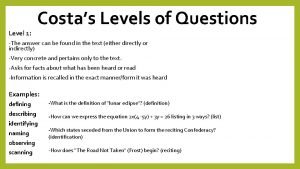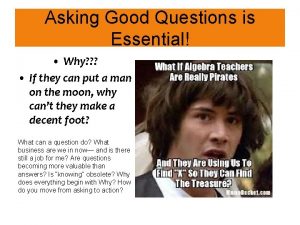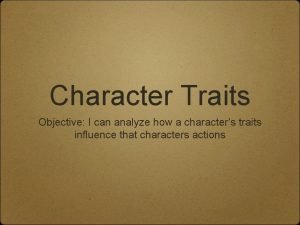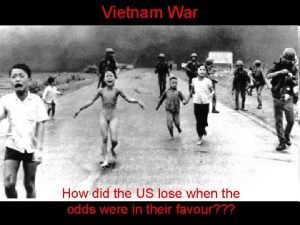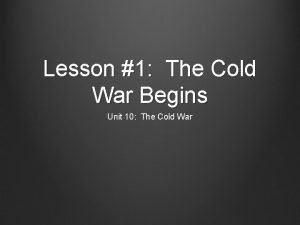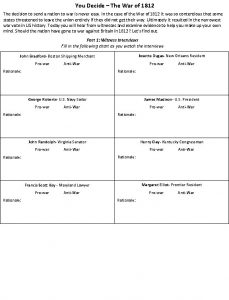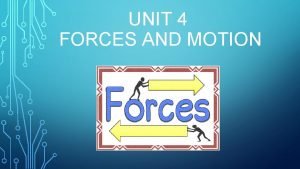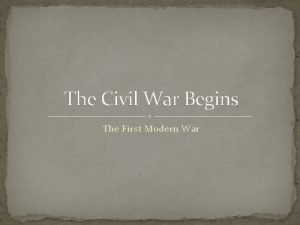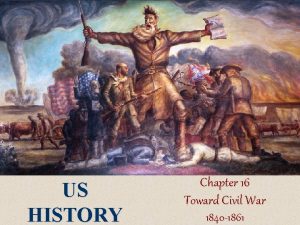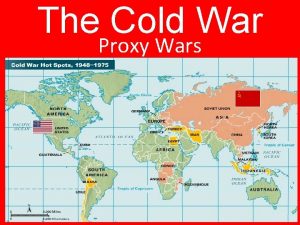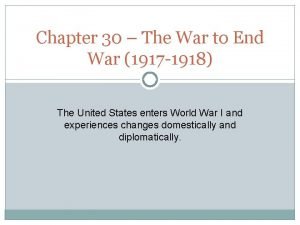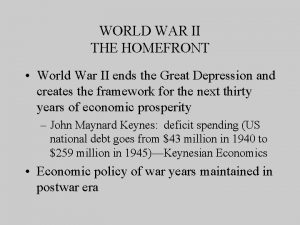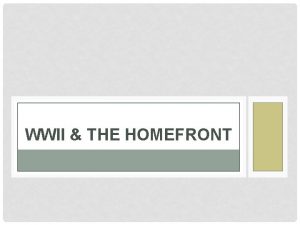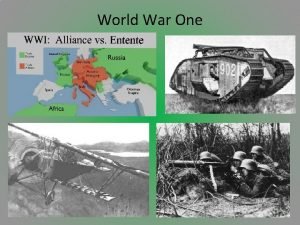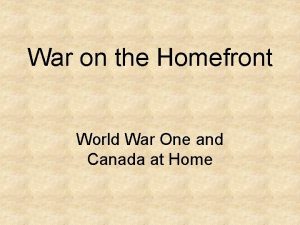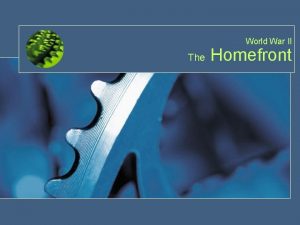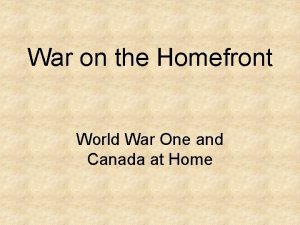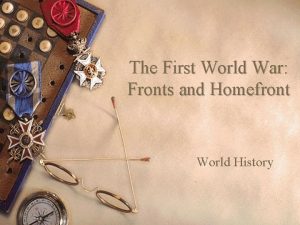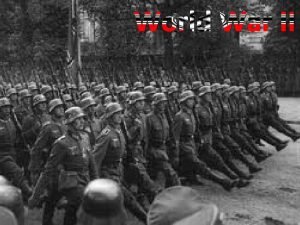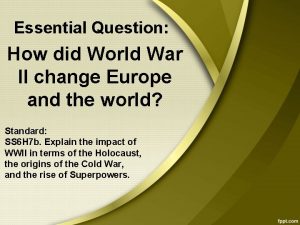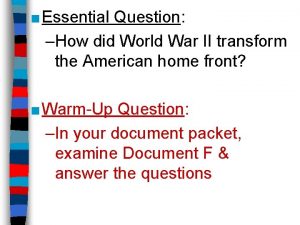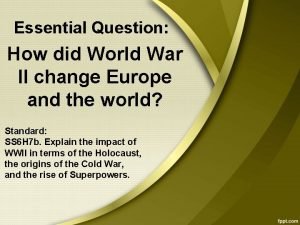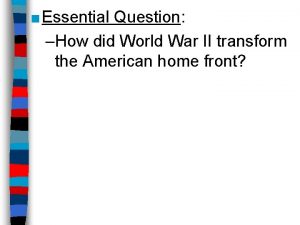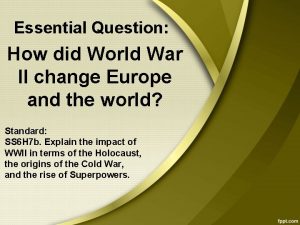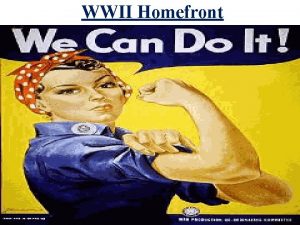World War II Homefront Essential Question How did








































- Slides: 40

World War II Homefront

Essential Question: • How did Americans mobilize and sacrifice on the home front during WWII? • What changes to society resulted from American involvement in World War II?


The Essential Standards: • 7. 1 Explain the impact of wars on American politics since Reconstruction (example): spheres of influence, isolationist practices, containment policies, first and second Red Scare movements, etc. • 7. 2 Explain the impact of wars on the American economy since Reconstruction (example): mobilizing for war, war industries, rationing, women in the workforce, lend-lease policy, WWII farming gains, GI Bill, etc. • 7. 3 Explain the impact of wars on American society and culture since Reconstruction (example): relocation of Japanese Americans, American propaganda, first and second Red Scare movement, Mc. Carthyism, baby boom, etc.

US Preparations for War • Prior to entering WWII, FDR began increasing the size of the US military and ordered increased production of war materials like planes • The government awarded factory owners with lucrative contracts to increase military production • After Pearl Harbor, almost all US industry was converted to military use

Selective Service and Training Act • Passed in 1940, after the fall of France to Germany • First peace-time draft in US history • Required 12 months service if drafted (requirement dropped during war) • All men ages 18 -36 had to register (expanded during WWII to ages 18 – 65) • Over the 7 years the act was in effect, over 10 million were drafted

War Production Board • Created after US entered the war to regulate war-time industry by deciding priorities, setting production goals, and controlling distribution of raw materials and supplies • Rationed fuel and materials vital to the war effort, such as gasoline, heating oil, metals, rubber, and plastics • Scrap drives: rubber, tin, aluminum, steel, animal fats and grease were all collected for recycling

War Production Board • Oversaw conversion of peacetime production to wartime production • Auto factories were among first converted to war production, making jeeps, tanks, trucks, and other gear • Henry Ford even began building bombers on his assembly lines • By end of WWII, auto industry had produced 1/3 of all US military supplies used

War Production Board • Oversaw production of Liberty Ships: Standardized cargo ships which could be produced quickly (could be built in just 42 days), cheaply, and in large numbers • Ships seams were welded, rather than riveted, which made them both cheaper and harder to sink • Over 2700 were built during the war, and only about 300 were sunk

Department of the Treasury • War cost more than $300 billion – more money than the US government had spent in its entire existence • Treasury issued War Bonds: sold over $150 billion in bonds (small private loans) • Income taxes: withheld directly from people’s paychecks for the first time; tax rate raised

Office of Price Administration • Fought inflation by freezing wages, prices, and rents • Sponsored rationing of goods --Ration books: to purchase many goods (tires, gas, silk stockings, etc. ), consumers had to have special coupons allowing them to buy • Americans accepted rationing as a personal contribution to the war; workers carpooled or rode bicycles to work • Encouraged Victory Gardens: Americans were encouraged to grow their own food where possible

Patriotism & Propaganda • Posters: America was covered with propaganda posters promoting everything from recycling to enlistment • Newsreels: movie theaters showed patriotic films, pro-US news clips to keep Americans motivated

Office of Scientific Research and Development • Created in 1941 to bring scientists into the war effort • Created improvements in radar and sonar • Encouraged the use of pesticides like DDT to fight insects • Pushed for the development of penicillin • Secret development of the atomic bomb, code named the Manhattan Project let by J. Robert Oppenheimer

How did United States’ involvement in World War II impact various groups of Americans? • • • Women African Americans Hispanic Americans Native Americans Japanese Americans

Women in the Military • US Army accepted women for the first time (Women’s Army Corp. WAC), but in non-combat roles, to free up more men for combat service • Over 275, 000 women would serve in the WAC & WAVES (US Navy’s Women Accepted for Volunteer Emergency Service)

Women in the Workforce • As men entered military service, women stepped into traditionally male roles, such as working in factories • More than 6 million women entered the US workforce and would show some reluctance to leave it after the war • Industries originally reluctant to hire women; but they proved that they could operate welding torches or riveting guns • Women earned about 60% of what men earned

Rosie the Riveter • Character based on a popular song about a woman who took a factory job to support her Marine boyfriend in the war • Became a nationally recognized symbol for the important role of women workers




“Double V” Campaign • Due to a segregated military, some African. Americans did not support the war • Others supported the idea of a “Double V” campaign – by fighting in the war, African-Americans could win a double victory – victories over Hitler’s racism abroad and over racism at home

Black Soldiers • Although the military remained segregated until after the war (1948), all-black units served with distinction and began to win respect from the military leadership and from their fellow soldiers

Tuskegee Airmen • 99 th Pursuit Squadron • All-black unit trained as fighter pilots at the Tuskegee Institute in Alabama • Once allowed to entire combat in the European Theater as bomber-escorts, they proved their ability by not losing a single bomber on missions in which they were providing the protection

Executive Order 8802 • Due to discriminatory hiring practices against African Americans, A. Philip Randolph, president of the Brotherhood of Sleeping Car Porters threatened a March on Washington • In response, Roosevelt issued an executive order in June 1941, banning racial discrimination in government hiring and in industries engaged as defense contractors • Established the Fair Employment Practices Commission to enforce the order – the first federal civil rights agency since Reconstruction ended • Defense plants hired more than 2 million minority workers

Native American Soldiers • Thousands of Native Americans served, especially in the Marine Corps • About 300 Navajo worked as “code talkers, ” using their native language to transmit radio messages for the Marines, a code which was never broken by the Japanese!

Bracero Program • Due to labor shortages on farms in the Southwest US, the federal government arranged for Mexican workers to help with the harvest • Over 200, 000 Mexicans entered the US as part of the Bracero Program, and began a tradition of US reliance on Latino migrant farmers

Zoot Suit Riots • June 1943 • Anti-Latino racism and a rise in juvenile crime, coupled with the “unpatriotic” fashion of “zoot suits” (large baggy suits which wasted material) which had been adopted by Mexican. American teens led to largescale fights between soldiers and Latinos in Los Angeles • Violence continued for days and led to a ban of Zoot Suits by the City of Los Angeles

Hispanic-American Soldiers • Despite episodes of racism, over 500, 000 Hispanic Americans served in the Armed Forces during the war, primarily Mexicans and Puerto Ricans • They served in every theater of the war and won 17 Medals of Honor

JAPANESE INTERNMENT CAMPS

Japanese Internment Camps • Fear of spies and saboteurs amongst the Japanese. American population on the West Coast prompted the US to “relocate” over 100, 000 to internment camps • Those interned lost homes, businesses, and jobs while detained from 1942 - 1945


Korematsu v. US • Dec. 1944 • Fred Korematsu sued the US government, claiming that his rights had been violated • US Supreme Court ruled that the internment camps were legal because they were a matter of “military urgency” and were not based on race, but also ruled that loyal US citizens can not be held against their will, prompting the government to begin releasing those held at the camps

Japanese-American Soldiers • Again, despite racism, many Japanese. Americans served in the US Armed Forces during the war, including the 442 nd Regimental Combat Team, who became the most decorated unit of the entire war

Population Shifts • Over 15 million Americans moved during the war to fill open jobs • Many moved into major industrial centers in the North, Midwest, and California, but more moved into the “Sunbelt” across the southern US • Once again, millions of blacks left the South for northern and western cities, leading to racial tensions (the Second Great Migration)

The GI Bill • Passed in 1944 • Designed to help GIs transition back to civilian life • Helped veterans by paying for college tuition, providing one year’s unemployment pay, and providing easy to get loans for purchasing housing or starting businesses

Growth of Middle Class • As hundreds of thousands of GIs became better educated and able to acquire better jobs, the middle-class in America grew significantly during the 1950 s • This expanded middle-class increased the demand for consumer goods and singlefamily housing

“Baby Boom” • Returning GIs were also anxious to marry and start families, leading to a dramatic surge in the birth rate from 1946 to 1964 • This generation of children, the largest in US history, came to be known as the “baby boomers”

Growth of Suburbs • Growth of middle-class families led to a dramatic spike in demand for housing • Since space was limited (and therefore expensive) in the cities, millions of Americans looked to the areas just outside of the cities to live and raise their families

William J. Levitt • 1907 – 1994 • Real estate developer who popularized building large developments of cheap “assembly line” style housing within commuting distance of major cities, areas called – “suburbs” • Affordable housing allowed many soldiers returning from WWII to marry and start families • First project was in Levittown, NY between 1947 -1951, where Levitt built over 17, 000 single-family homes

Levittown
 Homefront revolution holster weapon
Homefront revolution holster weapon Homefront wsgc
Homefront wsgc Costa questionnaire answers
Costa questionnaire answers Characteristics of lipids
Characteristics of lipids New world to old world columbian exchange
New world to old world columbian exchange Questions about figurative language
Questions about figurative language Essential question for pythagorean theorem
Essential question for pythagorean theorem Essential question generator
Essential question generator Essential questions for pythagorean theorem
Essential questions for pythagorean theorem Figurative language essential questions
Figurative language essential questions Individual vs. society
Individual vs. society Context clues essential questions
Context clues essential questions What is the essential question in cornell notes
What is the essential question in cornell notes Essential question definition
Essential question definition Essential questions for multiplication
Essential questions for multiplication Essential question gif
Essential question gif Essential questions for character traits
Essential questions for character traits Essential question cornell notes
Essential question cornell notes Essential questions for short stories
Essential questions for short stories War at home vs war abroad madison
War at home vs war abroad madison Description
Description Lesson 1 the cold war begins
Lesson 1 the cold war begins Presidential and congressional reconstruction venn diagram
Presidential and congressional reconstruction venn diagram Was john bradford pro war or anti war
Was john bradford pro war or anti war Ich bin du bist remse
Ich bin du bist remse Force and motion study jams
Force and motion study jams Why was the civil war the first modern war
Why was the civil war the first modern war Simple past bringen
Simple past bringen Chapter 16 lesson 2 challenges to slavery
Chapter 16 lesson 2 challenges to slavery Proxy wars in the cold war
Proxy wars in the cold war Chapter 30 the war to end war
Chapter 30 the war to end war Chapter 30 the war to end war
Chapter 30 the war to end war War photographer carol ann duffy analysis
War photographer carol ann duffy analysis Questions without question words
Questions without question words Closed questions
Closed questions Contoh open question
Contoh open question Situation producing questions examples
Situation producing questions examples Direct indirect questions
Direct indirect questions Compelling questions examples
Compelling questions examples Compelling questions definition
Compelling questions definition What did americans underestimate in their eagerness for war
What did americans underestimate in their eagerness for war


